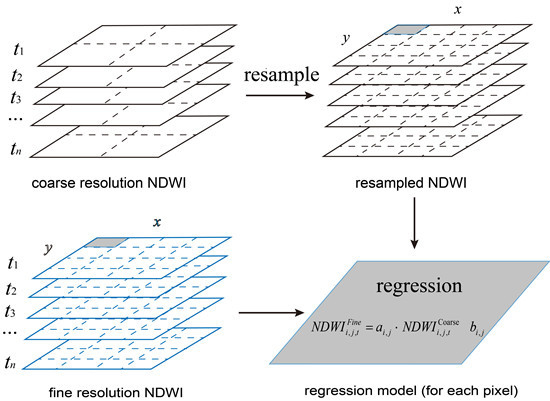Downscaling Surface Water Inundation from Coarse Data to Fine-Scale Resolution: Methodology and Accuracy Assessment
Abstract
:1. Introduction
2. Methodology
2.1. Water Delineation Method
2.2. Downscaling Method: ALinear Calibration of the Coarse Resolution NDWI towards Fine Resolution NDWI
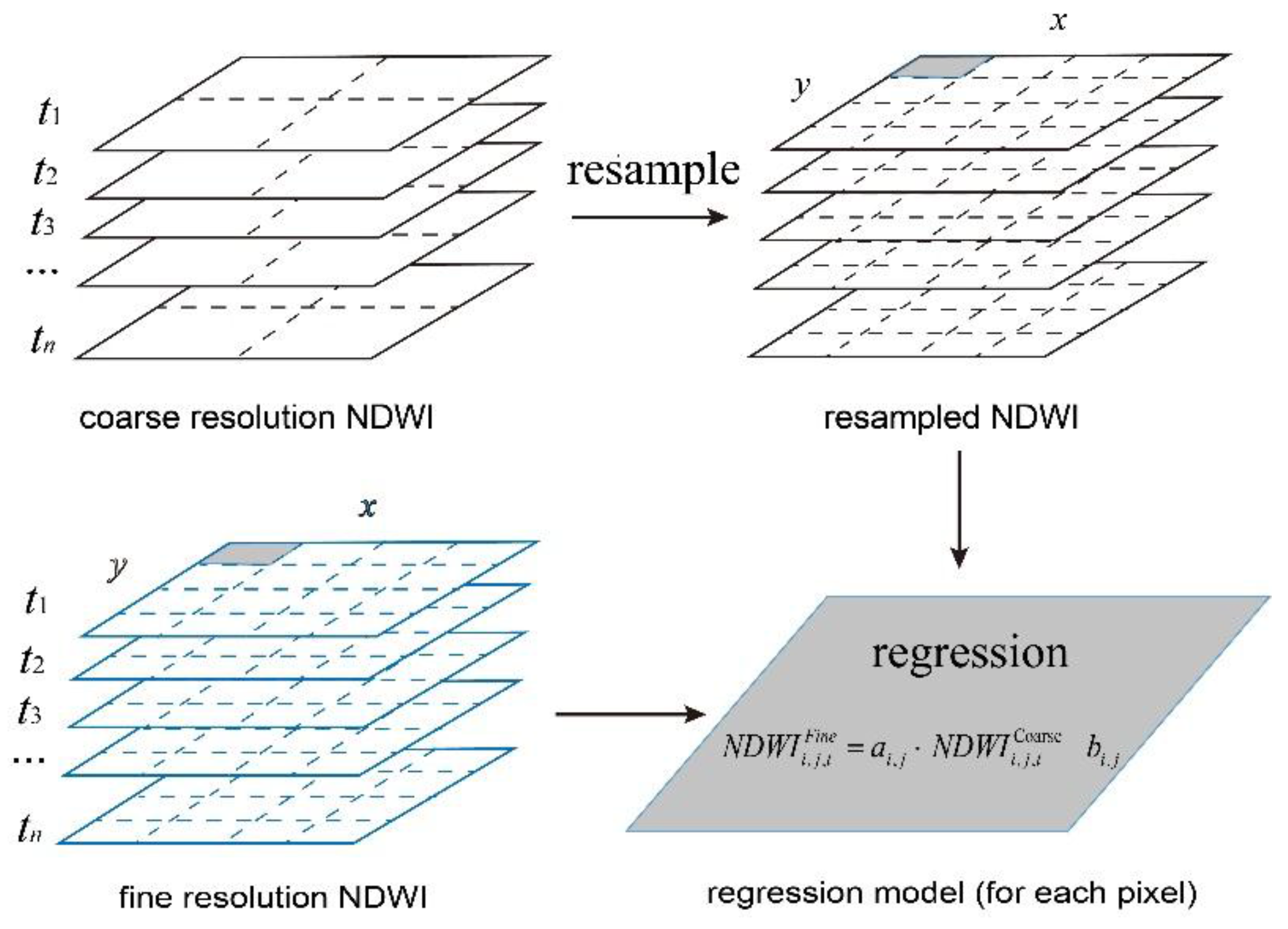
2.3. Evaluation Criteria
2.3.1. Quantity-Level Comparison
2.3.2. Landscape-Level Comparison
| Landscape Metrics | Metric Description | Units | Equation |
|---|---|---|---|
| Number of Patches (NP) | number of patches in the water body | NA | |
| Edge Density (ED) | the sum of the lengths (m) of all edge segments in the landscape, divided by the total inundation area(ha) | m/ha | (10,000) ek: total length of edge A: total landscape area |
| Fractal Mean Number (FRAC_MN) | an area-weighted mean of the fractal dimension index for each patch in the inundation class | NA | Pi: perimeter of patch i; ai: area of patch i. |
| Mean Perimeter-to-Area (PARA_MN) | the mean ratio of the patch perimeter (m) to area (m2) | NA | |
| Aggregation Index (AI) | number of like adjacencies involving the corresponding class, divided by the maximum possible number of that. | Percentage | g: number of like adjacencies between pixels of water patch; : maximum number of like adjacencies between pixels of water patch. |
3. Materials and Data Processing
3.1. Study Area
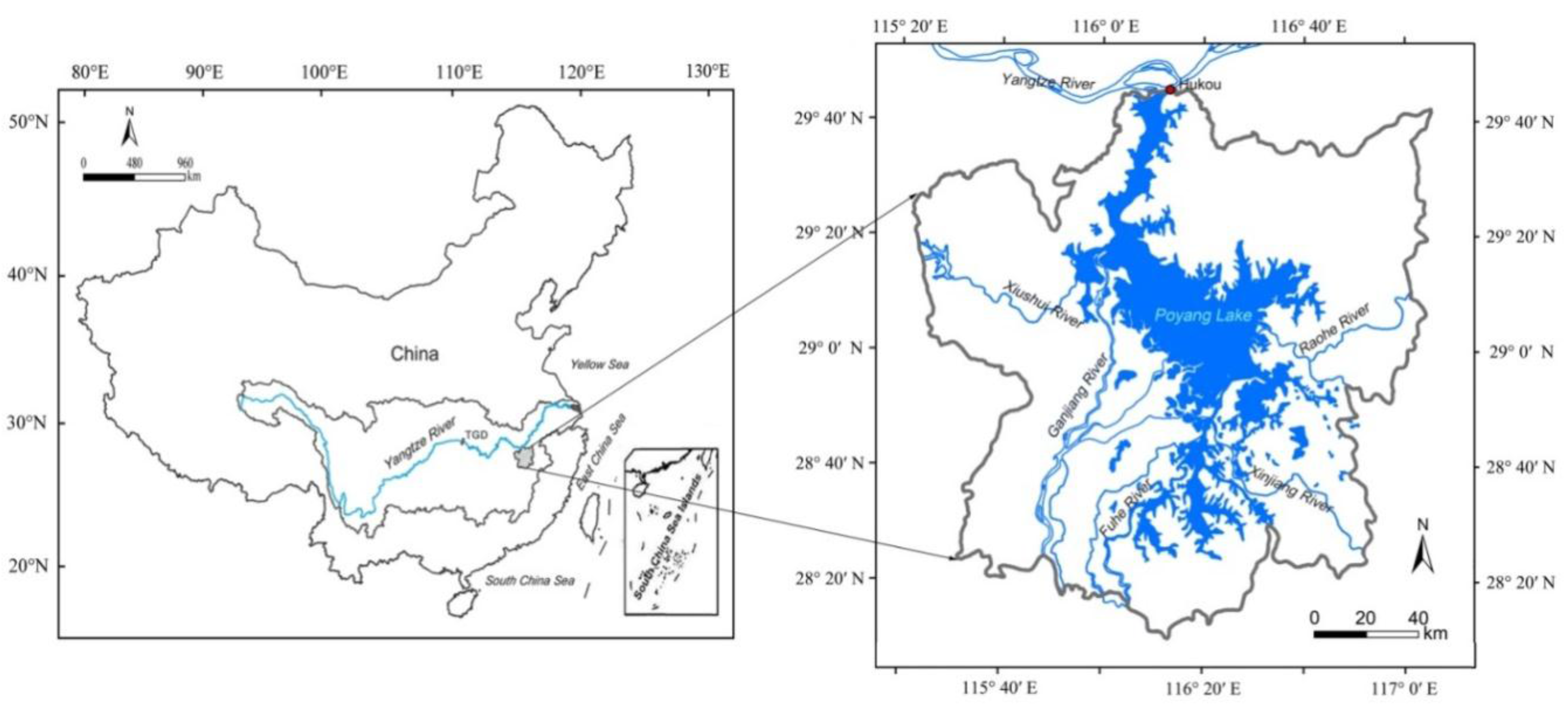
3.2. Data Acquisition and Processing
| Satellite Imagery | Spatial Resolution (m) | Spectral Resolution (μm) | Band | Temporal Coverage | Scene | |
|---|---|---|---|---|---|---|
| EOS-Terra | MOD02_HKM | 500 | Green: 0.54–0.57 | 4 | 2000–2012 | 466 |
| MOD02_QKM | 250 | NIR: 0.84–0.88 | 2 | |||
| Landsat | TM/ETM+ | 30 | Green: 0.52–0.60 | 2 | 55 | |
| NIR: 0.76–0.90 | 4 | |||||
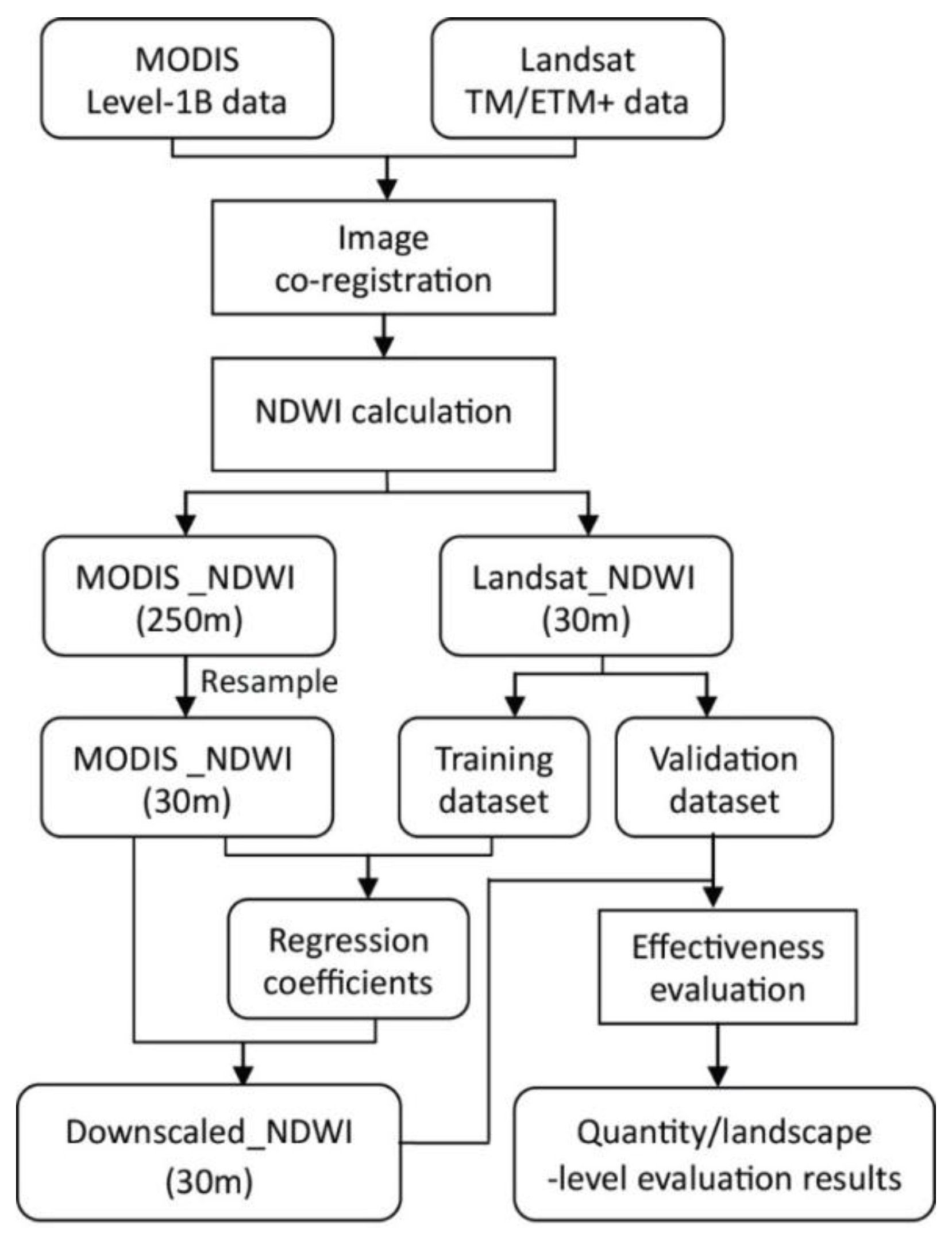
4. Results and Discussion
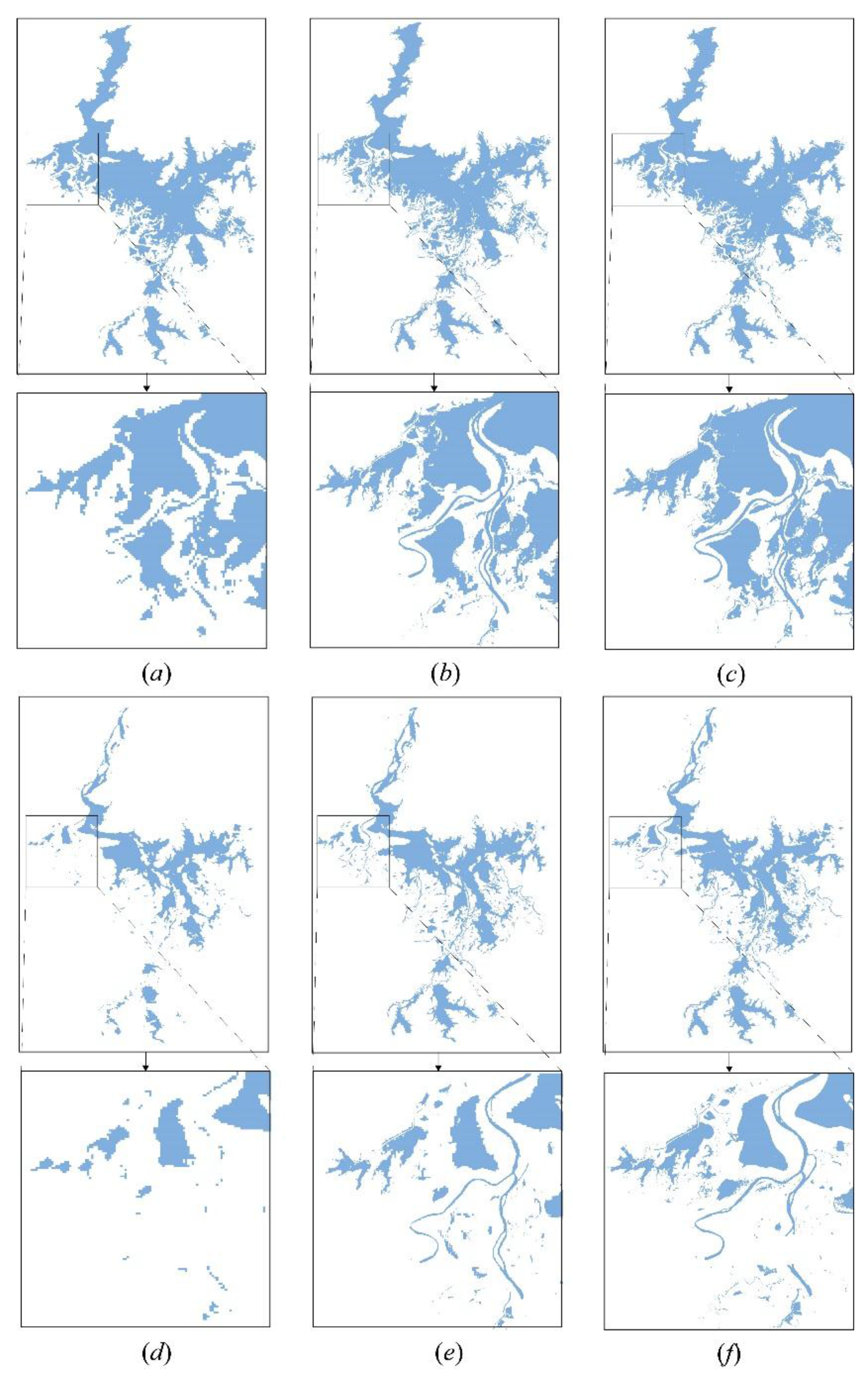
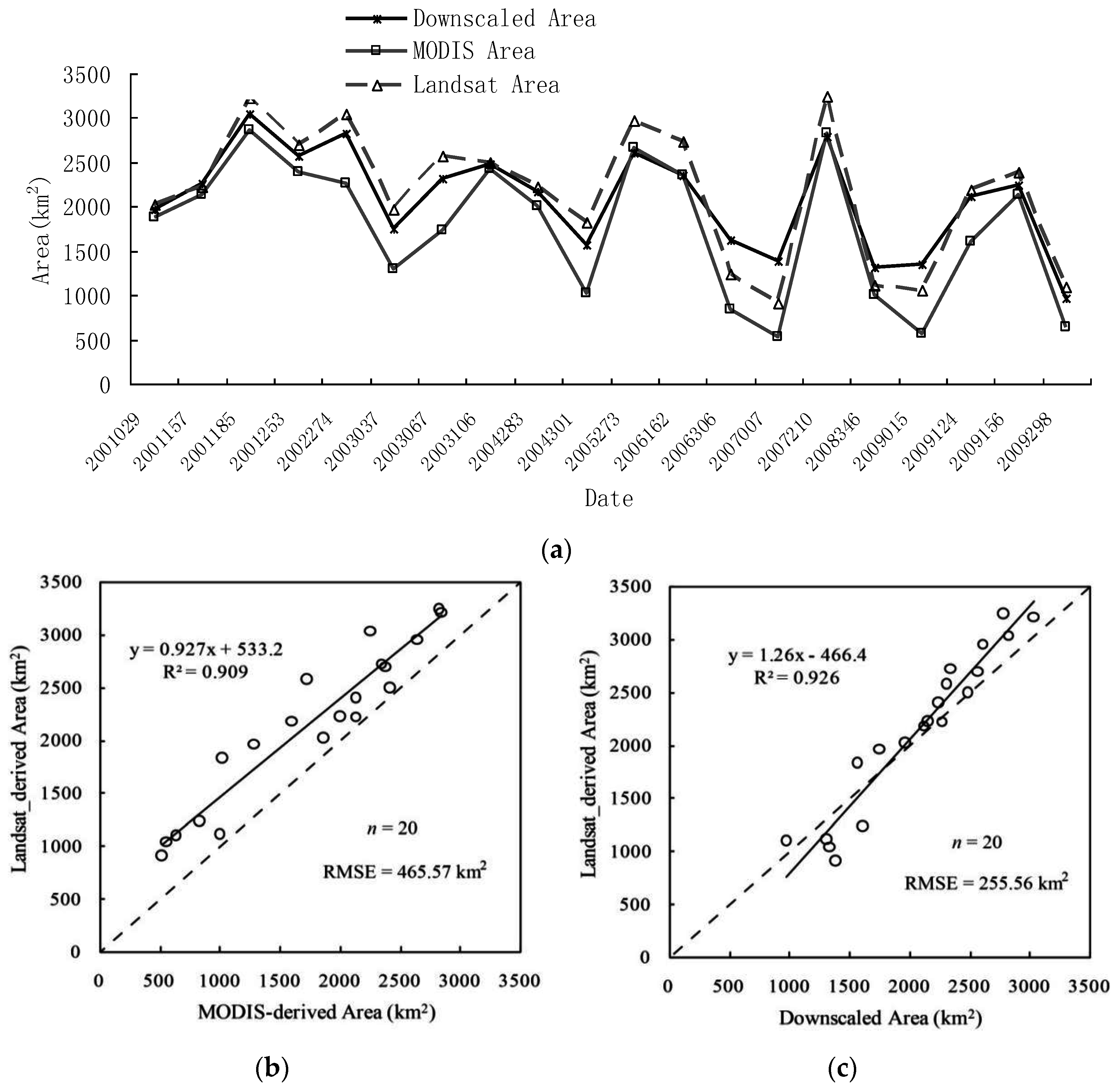

| Landscape Metrics | Average Value | Landsat (30 m) versus MODIS (250 m) | Landsat (30 m) versus Downscaled-MODIS (30 m) | ||||||
|---|---|---|---|---|---|---|---|---|---|
| MODIS (250 m) | MODIS (30 m) | Landsat (30 m) | R2 | RMSE | MAE | R2 | RMSE | MAE | |
| Number of Patches (NP) | 238 | 3856 | 4014 | 0.144 | 3724.74 | 3618.58 | 0.914 | 318.89 | 270.68 |
| Edge Density (ED) | 1.72 | 6.08 | 7.45 | 0.147 | 4.42 | 4.36 | 0.556 | 1.54 | 1.38 |
| Fractal Mean Number (FRAC_MN) | 1.03 | 1.06 | 1.05 | 0.180 | 0.023 | 0.022 | 0.673 | 0.005 | 0.004 |
| Mean perimeter-to-area (PARA_MN) | 110.14 | 853.61 | 867.29 | 0.069 | 743.81 | 743.47 | 0.323 | 23.21 | 19.34 |
| Aggregation index (AI) | 89.53 | 96.57 | 97.23 | 0.279 | 7.64 | 7.03 | 0.515 | 1.16 | 1.02 |
5. Conclusions
Acknowledgments
Author Contributions
Conflicts of Interest
References
- Yu, G.E.; Harrison, S.P. Holocene changes in atmospheric circulation patterns as shown by lake status changes in northern Europe. Boreas 1995, 24, 260–268. [Google Scholar] [CrossRef]
- Beeton, A.M. Large freshwater lakes: Present state, trends, and future. Environ. Conserv. 2002, 29, 21–38. [Google Scholar] [CrossRef]
- Williamson, C.E.; Saros, J.E.; Vincent, W.F.; Smol, J.P. Lakes and reservoirs as sentinels, integrators, and regulators of climate change. Limnol. Oceanogr. 2009, 54, 2273–2282. [Google Scholar] [CrossRef]
- Finlayson, M.; Cruz, R.D.; Davidson, N. Ecosystems and Human Well-Being: Welands and Water; World Resources Institute: Washington, DC, USA, 2005; Chapter 20. [Google Scholar]
- Nel, J.L.; Roux, D.J.; Abell, R.; Ashton, P.J.; Cowling, R.M.; Higgins, J.V. Progress and challenges in freshwater conservation planning. Aquat. Conserv. 2009, 19, 474–485. [Google Scholar] [CrossRef]
- Li, W.B.; Du, Z.Q.; Ling, F.; Zhou, D.B.; Wang, H.L.; Gui, Y.M.; Sun, B.Y.; Zhang, X.M. A comparison of land surface water mapping using the normalized difference water index from TM, ETM+ and ALI. Remote Sens. 2013, 5, 5530–5549. [Google Scholar] [CrossRef]
- Fluet-Chouinard, E.; Lehner, B.; Rebelo, L-M.; Papa, F.; Hamilton, S.K. Development of a global inundation map at high spatial resolution from topographic downscaling of coarse-scale remote sensing data. Remote Sens. Environ. 2015, 158, 348–361. [Google Scholar] [CrossRef]
- Alsdorf, D.E.; Rodriguez, E.; Letternmaier, D.P. Measuring surface water from space. Rev. Geophys. 2007, 45, RG2002. [Google Scholar] [CrossRef]
- Birkett, C.M. Synergistic remote sensing of Lake Chad: variability of basin inundation. Remote Sens. Environ. 2000, 72, 218–236. [Google Scholar] [CrossRef]
- Alsdorf, D.E.; Lettenmaier, D.P. Tracking fresh water from space. Science 2003, 301, 1492–1494. [Google Scholar] [CrossRef] [PubMed]
- Cazenave, A.; Milly, P.C.D.; Douville, H.; Benveniste, J.; Kosuth, P.; Lettenmaier, D. Space techniques used to measure change in terrestrial waters. EOS Trans. 2004, 85. [Google Scholar] [CrossRef]
- Du, Z.; Li, W.; Zhou, D.; Tian, L.; Liang, F.; Wang, H.; Gui, Y.; Sun, B. Analysis of Landsat-8 OLI imagery for land surface water mapping. Remote Sens. Lett. 2014, 5, 672–681. [Google Scholar] [CrossRef]
- Smith, L.C. Satellite remote sensing of river inundation area, stage, and discharge: A review. Hydrol. Process. 1997, 11, 1427–1439. [Google Scholar] [CrossRef]
- Frazier, P.S.; Page, K.J. Water body detection and delineation with Landsat TM data. Photogramm. Eng. Remote Sens. 2000, 66, 1461–1467. [Google Scholar]
- Jain, S.K.; Singh, R.D.; Jain, M.K.; Lohani, A.K. Delineation of flood-prone areas using remote sensing techniques. Water Resour. Manag. 2005, 19, 333–347. [Google Scholar] [CrossRef]
- Huang, C.; Chen, Y.; Wu, J.; Li, L.; Liu, R. An evaluation of Suomi NPP-VIIRS data for surface water detection. Remote Sens. Lett. 2015, 6, 155–164. [Google Scholar] [CrossRef]
- Hang, C.; Chen, Y.; Wu, J. Mapping spatio-temporal flood inundation dynamics at large river basin scale using time-series flow data and MODIS imagery. Int. J. Appl. Earth Obs. Geoinform. 2014, 26, 350–362. [Google Scholar] [CrossRef]
- Brakenridge, G.R.; Anderson, E. MODIS-based flood detection, mapping and measurement: The potential for operational hydrological applications. Transbound. Floods: Reduc. Risks Flood Manag. 2006, 72, 1–12. [Google Scholar]
- Huang, S.F.; Li, J.G.; Xu, M. Water surface variations monitoring and flood hazard analysis in Dongting Lake area using long-term Terra/MODIS data time series. Nat. Hazards 2012, 62, 93–100. [Google Scholar] [CrossRef]
- Feng, L.; Hu, C.M.; Chen, X.L.; Cai, X.B.; Tian, L.Q.; Gan, W.X. Assessment of inundation changes of Poyang Lake using MODIS observations between 2000 and 2010. Remote Sens. Environ. 2012, 121, 80–92. [Google Scholar] [CrossRef]
- Li, S.; Sun, D.; Glodberg, M.; Stefanidis, A. Derivation of 30-m-resolution water maps from TERRA/MODIS and SRTM. Remote Sens. Environ. 2013, 134, 417–430. [Google Scholar] [CrossRef]
- Lyons, E.A.; Sheng, Y.W.; Smith, L.C.; Li, J.L.; Hinkel, K.M.; Lenters, J.D.; Wang, J.D. Quantifying sources of error in multitemporal multisensor lake mapping. Int. J. Remote Sens. 2013, 34, 7887–7905. [Google Scholar] [CrossRef]
- Bryant, R.G.; Rainey, M.P. Investigation of flood inundation on playas within the Zone of Chotts, using a time-series of AVHRR. Remote Sens. Environ. 2002, 82, 360–375. [Google Scholar] [CrossRef]
- Atkinson, P.M. Downscaling in remote sensing. Int. J. Appl. Earth Obs. Geoinform. 2013, 22, 106–114. [Google Scholar] [CrossRef]
- Bierkens, M.F.P.; Finke, P.A.; Willigen, D.E. Upscaling and Downscaling Methods for Environmental Research; Kluwer Academic: Dordrech, The Netherlands, 2000. [Google Scholar]
- Galantowicz, J. High-resolution flood mapping from low-resolution passive microwave satellite observations. In Proceedings of the IEEE International Geoscience and Remote Sensing Symposium, Toronto, ON, Canada, 2002; pp. 1499–1502.
- Aires, F.; Papa, F.; Prigent, C. A long-term, high-resolution wetland dataset over the AmazonBasin, downscaled from a multi-wavelength retrieval using SAR data. J. Hydrometeorol. 2013, 14, 594–607. [Google Scholar] [CrossRef]
- Ling, F.; Xiao, F.; Du, Y.; Xue, H.P.; Ren, X.Y. Waterline mapping at the subpixel scale from remote sensing imagery with high-resolution digital elevation models. Int. J. Remote Sens. 2008, 29, 1809–1815. [Google Scholar] [CrossRef]
- Huang, C.; Chen, Y.; Wu, J.P. DEM-based modification of pixel-swapping algorithm for enhancing floodplain inundation mapping. Int. J. Remote Sens. 2014, 35, 365–381. [Google Scholar] [CrossRef]
- Aires, F.; Papa, F.; Prigent, C. Characterization and space-time downscaling of the inundation extent over the Inner Niger Delta using GIEMS and MODIS data. J. Hydrometeorol. 2014, 15, 171–192. [Google Scholar] [CrossRef]
- Pontius, J.R.G.; Millones, M. Death to Kappa: Birthof quantity disagreement and allocation disagreement for accuracy assessment. Int. J. Remote Sens. 2011, 32, 4407–4429. [Google Scholar] [CrossRef]
- Chen, H.; Xu, C.Y.; Guo, S.L. Comparison and evaluation of multiple GCMs, statistical downscaling and hydrological models in the study of climate change impacts on runoff. J. Hydrol. 2012, 434, 36–45. [Google Scholar] [CrossRef]
- Maraun, D.; Wetterhall, F.; Ireson, A.M.; Chandler, R.E.; Kendon, E.J.; Widmann, M.; Brienen, S.; Rust, H.W.; Sauter, T.; Themeßl, M.; et al. Precipitation downscaling under climate change: Recent developments to bridge the gap between dynamical models and the end user. Rev. Geophys. 2010, 48, 1–38. [Google Scholar] [CrossRef]
- Liu, Y.B.; Song, P.; Peng, J.; Ye, C. A physical explanation of the variation in threshold for delineating terrestrial water surface from multi-temporal images: Effects of radiometric correction. Int. J. Remote Sens. 2012, 33, 5862–5875. [Google Scholar] [CrossRef]
- McFeeters, S.K. The use of the normalized difference water index (NDWI) in the delineation of open water features. Int. J. Remote Sens. 1996, 17, 1425–1432. [Google Scholar] [CrossRef]
- Turner, M.G. Spatial and temporal analysis of landscape patterns. Landscape. Ecol. 1990, 4, 21–30. [Google Scholar] [CrossRef]
- Wu, J. Effects of changing scale on landscape patterns analysis: Scaling relations. Landsc. Ecol. 2004, 19, 125–138. [Google Scholar] [CrossRef]
- Walz, U. Monitoring of landscape change and functions in Saxony (Eastern Germany)-Methods and indicators. Ecol. Indic. 2008, 8, 807–817. [Google Scholar] [CrossRef]
- Gustafson, E.J. Quantifying landscape spatial pattern: What is the state of the art? Ecosystem 1998, 1, 143–156. [Google Scholar] [CrossRef]
- Liu, Y.B.; Nishiyama, S.; Kusaka, T. Examining Landscape dynamics at a watershed scale using landsat TM imagery for detection of wintering hooded crane decline in Yashiro, Japan. Environ. Manag. 2003, 31, 365–376. [Google Scholar] [CrossRef] [PubMed]
- Robert, H.G.J.; Trani, M.K. Key elements of landscape pattern measures. Environ. Manag. 1999, 23, 477–481. [Google Scholar]
- De Beer, Y.; van Aarde, R.J. Do landscape heterogeneity and water distribution explain aspects of elephant home range in southern Africa’s arid savannas? J. Arid Environ. 2008, 72, 2017–2025. [Google Scholar] [CrossRef]
- Cao, X.; Ding, S. Landscape pattern dynamics of water body in Kaifeng city in the 20th century. J. Geogr. Sci. 2005, 15, 106–114. [Google Scholar] [CrossRef]
- McGarigal, K.; Marks, B. Spatial Pattern Analysis Program for Categorical Maps: Computer Software; University of Massachusetts: Amherst, MA, USA, 2002. [Google Scholar]
- Finlayson, M.; Harris, J.; McCartney, M.; Lew, Y.; Zhang, C. Report on Ramsar Visit to Poyang Lake Ramsar Site, PR China. Available online: http://archive.ramsar.org/pdf/Poyang_lake_report_v8.pdf (accessed on 12 April 2010).
- Wu, G.P.; Liu, Y.B. Capturing variations in inundation with satellite remote sensing in a morphologically complex, large lake. J. Hydrol. 2015, 523, 14–23. [Google Scholar] [CrossRef]
- Hui, F.; Xu, B.; Huang, H.; Yu, Q.; Gong, P. Modelling spatial-temporal change of Poyang Lake using multitemporal Landsat imagery. Int. J. Remote Sens. 2008, 29, 5767–5784. [Google Scholar] [CrossRef]
- Shankman, D.; Keim, B.D.; Song, J. Flood frequency in China’s Poyang Lake region: Trends and teleconnections. Int. J. Climatol. 2006, 26, 1255–1266. [Google Scholar] [CrossRef]
- USGS. What Is Landsat 7 ETM+ SLC-off Data? Available online: http://landsat.usgs.gov/Landsat_7_ETM_SLC_off_data.php (accessed on 8 November 2013).
© 2015 by the authors; licensee MDPI, Basel, Switzerland. This article is an open access article distributed under the terms and conditions of the Creative Commons by Attribution (CC-BY) license (http://creativecommons.org/licenses/by/4.0/).
Share and Cite
Wu, G.; Liu, Y. Downscaling Surface Water Inundation from Coarse Data to Fine-Scale Resolution: Methodology and Accuracy Assessment. Remote Sens. 2015, 7, 15989-16003. https://doi.org/10.3390/rs71215813
Wu G, Liu Y. Downscaling Surface Water Inundation from Coarse Data to Fine-Scale Resolution: Methodology and Accuracy Assessment. Remote Sensing. 2015; 7(12):15989-16003. https://doi.org/10.3390/rs71215813
Chicago/Turabian StyleWu, Guiping, and Yuanbo Liu. 2015. "Downscaling Surface Water Inundation from Coarse Data to Fine-Scale Resolution: Methodology and Accuracy Assessment" Remote Sensing 7, no. 12: 15989-16003. https://doi.org/10.3390/rs71215813





